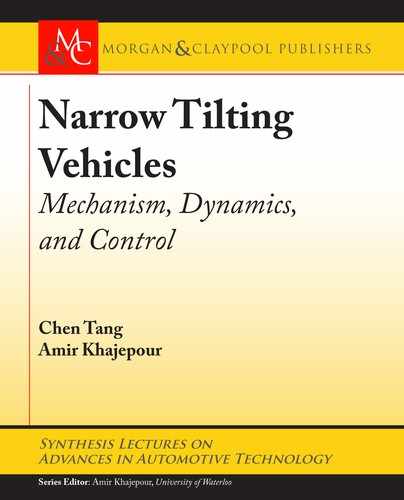4.7. HOLISTIC ENVELOPE CONTROL: MPC DESIGN EXAMPLE 49
SMC Case B: Robustness to Tilting Actuator Failure
To demonstrate the robustness of the proposed integrated control architecture, the vehicle con-
figuration with the following Case 5 is adopted.
• Case 5 – Same configuration as Case 4, but tilting actuator could fail during runtime:
R
Case5
D diag
1 0 1 0 0 0 1 0 1 1 0 1 R
Tx
.t/
;
where R
Tx
.t/ is the diagnosis of the actuator health condition which can be determined by al-
gorithms suggested in [21, 39, 63].
A failure is triggered from time t D 4 s with tilting torque output drops to zero. Two
scenarios are compared. One assumes there is no flexibility in the control architecture to handle
such faults, and the controller is not notified about the system change and still expects the ac-
tuator to exert the same amount of torque in its normal state as Case 4; in the other scenario, a
fault-diagnostic system could capture the failure as Case 5 and reformulate the optimal distri-
butions online. Considering the driver might not immediately realize the system faults, vehicle
speed is assumed to remain unchanged at 60 km/h for both scenarios. Results are shown in
Figure 4.9.
e baseline case (Case 1) drives the vehicle with a fishhook maneuver. Since no active
tilting control is involved, the LTR index could reach more than 0:7. With the demonstrated
integrated control of multiple actuators, vehicle LTR indices of both can be significantly reduced
when there is no system faults (t < 4 s). After tilting actuator fault is triggered, the vehicle
behavior without control reconstruction will put the vehicle into the high rollover danger again
as the baseline case [70]. However, with the proposed re-configurable approach, control efforts
can be re-distributed online to react to system changes. Vehicle rollover stability could still be
maintained at a safe level, with minimum impacts to motions in other directions.
4.7 HOLISTIC ENVELOPE CONTROL: MPC DESIGN
EXAMPLE
Previous sections represent two different approaches to tackle the tilting control problem: a sep-
arate tilting control and an integrated stability control with active tilting formulations. e idea
of the roll envelope derived from the steady-state assumptions are adopted in both architectures.
Good performances have been demonstrated, however ignoring the transient roll dynamics still
limits their performances.
is section explores how the full roll envelope as constraints can be incorporated in
the control system design, which leads to enhanced performances. More specifically, the non-
minimum phase problem with active roll motion control is discussed, and the model predictive
controller is presented to tackle the control problem. For clarity, the envelope-based MPC ex-
clusively for roll motion control is presented first, followed by the integrated stability envelope
approach.

50 4. TILTING VEHICLE CONTROL
δ
d
(deg)r (rad/s)φ (deg)
LTRa
y
(m/s
)T
x
(N.m)
5
0
-5
δ
cfr
(deg)
3
2
1
0
-1
5
0
-5
1
0.5
0
-0.5
-1
0.4
0.2
0
-0.2
-0.4
0 2 4 86 0 2 4 86
0 2 4 86 0 2 4 86
0 2 4 86 0 2 4 86
0 2 4 86 0 2 4 86
6
0
-5
1
0.5
0
-0.5
-1
∆Q
cfr
(N.m)
200
0
-200
-400
-600
× 10
4
Base
Time (s) Time (s)
AT+AFS+TV (without fault reconfig.) AT+AFS+TV (with fault reconfig.)
Failure
Figure 4.9: Roll envelope-based control with actuator failure.
..................Content has been hidden....................
You can't read the all page of ebook, please click here login for view all page.
